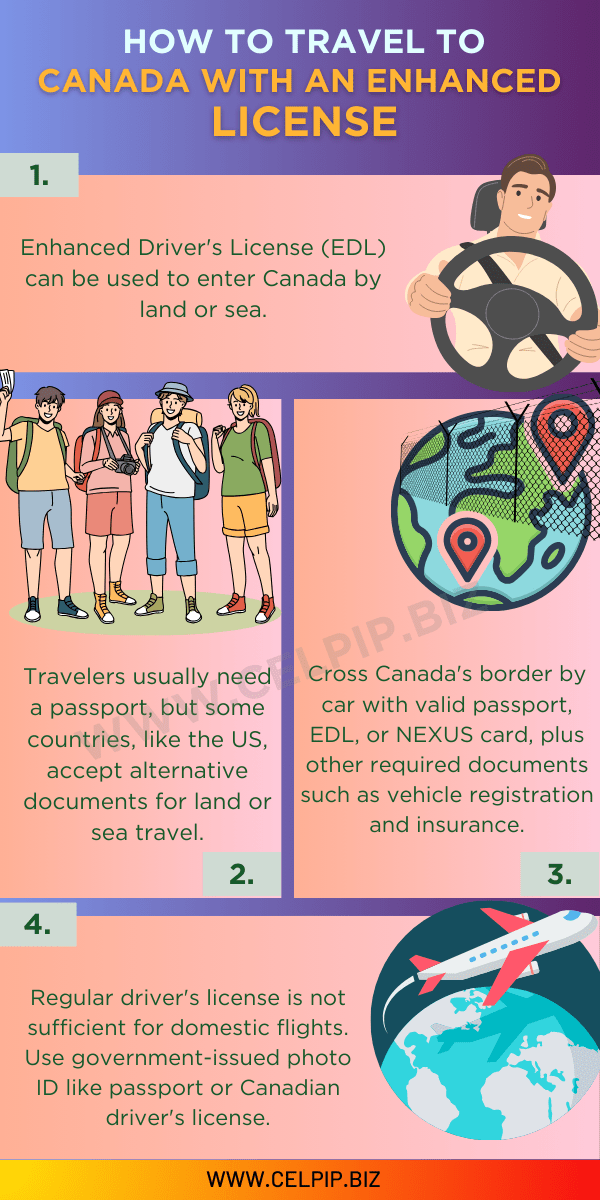Travel to Canada: As the allure of exploring Canada’s vast landscapes, vibrant cities, and rich cultural tapestry beckons, travelers often find themselves faced with the logistical challenge of crossing the border.
Amidst the array of documentation options, an enhanced license emerges as a convenient and efficient solution for streamlined entry into the Great White North.
Today in this article we will delve into the intricacies of traveling to Canada with an enhanced license.
From demystifying the concept of enhanced licenses to outlining the benefits they offer, we equip you with the essential knowledge to embark on your Canadian adventure seamlessly.
Whether you’re a seasoned traveler or a first-time visitor, understanding the nuances of enhanced licenses is key to ensuring a hassle-free border crossing experience.
So let’s navigate through the requirements, advantages, and practical considerations associated with using an enhanced license for travel to Canada.
What is an Enhanced License?
An Enhanced Driver’s License (EDL) is a type of government-issued identification that serves as both a driver’s license and a passport alternative for certain cross-border travel.
It’s designed to provide additional security features and comply with the Western Hemisphere Travel Initiative (WHTI), which mandates secure documentation for entry into the United States, Canada, Mexico, and some Caribbean countries.
Here are key features and aspects of an Enhanced License:
- Identification – An EDL typically includes the same information as a standard driver’s license, such as the holder’s name, date of birth, address, and a photograph. However, it also contains additional security features to prevent counterfeiting and ensure authenticity.
- Cross-Border Travel – One of the primary purposes of an EDL is to facilitate land and sea travel between the United States and Canada, as well as other WHTI-compliant countries, without requiring a passport. This can be particularly convenient for frequent travelers who frequently cross these borders for business or leisure.
- Security Features – Enhanced licenses incorporate advanced security features to prevent tampering and counterfeiting. These may include RFID (Radio Frequency Identification) chips, holographic overlays, and other technologies that make the license difficult to replicate.
- Compliance – Enhanced licenses are issued in compliance with specific regulations set forth by the government, ensuring that they meet the standards for international travel as outlined by the WHTI. This means they’re recognized and accepted by border authorities for entry into participating countries.
- Limited Use – While an EDL is suitable for land and sea travel to certain countries, it may not be valid for air travel or for entry into countries beyond those covered by the WHTI. Travelers should always check the specific entry requirements of their destination country before relying solely on an enhanced license.
- Application Process – Obtaining an enhanced license typically involves a similar application process to that of a standard driver’s license, but with additional documentation requirements to verify identity and citizenship. These requirements may vary depending on the issuing state or province.
Requirements for Traveling to Canada with an Enhanced License
Traveling to Canada with an Enhanced Driver’s License (EDL) involves meeting specific requirements set by both the Canadian government and the issuing authority of the EDL, typically a state or provincial Department of Motor Vehicles (DMV). Here’s a detailed breakdown of the requirements:
- Possession of an Enhanced Driver’s License – The primary requirement for traveling to Canada with an enhanced license is, of course, possessing a valid EDL. This means you must have successfully applied for and been issued an EDL by the appropriate state or provincial authority.
- Citizenship and Residency – Generally, only citizens or residents of the issuing country or province are eligible to apply for an EDL. Therefore, to use an EDL for travel to Canada, you must be a citizen or resident of the country or province that issued the license.
- Verification of Identity and Citizenship – The application process for an EDL typically involves providing documentation to verify your identity and citizenship. This may include presenting a birth certificate, passport, social security card, or other forms of identification specified by the issuing authority.
- No Outstanding Legal Issues – It’s essential to have a clean legal record with no outstanding warrants, unresolved legal matters, or restrictions that would prevent you from crossing international borders. Any legal issues may hinder your ability to travel to Canada, regardless of the type of identification you possess.
- Meeting Canadian Entry Requirements – While an EDL is a valid form of identification for entry into Canada by land or sea, travelers must still meet other entry requirements set by Canadian immigration authorities. This may include having a valid reason for travel, sufficient funds for the duration of stay, and compliance with any immigration regulations or restrictions.
- Additional Documentation – While an EDL is sufficient for many travelers crossing the Canadian border, it’s advisable to carry additional documentation as a backup. This may include a passport, birth certificate, or other forms of identification, especially if you anticipate encountering any issues or if you plan to travel by air.
- Understanding Limitations – It’s important to be aware of any limitations associated with using an EDL for travel to Canada. For example, an EDL may not be accepted for certain types of travel, such as air travel, or for entry into countries other than Canada and those covered by the Western Hemisphere Travel Initiative (WHTI).

Limitations on Using an Enhanced License for Travel to Canada
Using an Enhanced Driver’s License (EDL) for travel to Canada comes with certain limitations that travelers should be aware of to avoid any complications at the border. Here are the key limitations associated with using an EDL for travel to Canada:
- Limited Acceptance – While an EDL is recognized as a valid form of identification for entry into Canada by land or sea, it may not be accepted for all types of travel or entry points. For example, it may not be sufficient for air travel to Canada, as airlines often require passengers to present a passport or other accepted travel documents.
- Restricted International Travel – An EDL is primarily designed for travel within the Western Hemisphere, as part of the Western Hemisphere Travel Initiative (WHTI). While it allows for easy border crossings between the United States, Canada, Mexico, and some Caribbean countries, it may not be valid for entry into countries outside of this region. Travelers planning to visit countries beyond those covered by the WHTI should carry a passport or other accepted travel documents.
- Non-Compliance with Canadian Entry Requirements – While an EDL serves as proof of identity and citizenship for entry into Canada, travelers must still meet other entry requirements set by Canadian immigration authorities. This includes having a valid reason for travel, sufficient funds for the duration of stay, and compliance with any immigration regulations or restrictions. Failure to meet these requirements may result in denial of entry, regardless of possessing an EDL.
- Not Universally Accepted – While many border crossings between the United States and Canada accept EDLs, some remote or less frequented entry points may not be equipped to process them. In such cases, travelers may be required to present a passport or other accepted travel documents for entry.
- Not Suitable for All Situations – While an EDL is a convenient option for many travelers, there may be situations where it’s advisable or necessary to carry additional documentation. For example, if you plan to travel internationally by air or anticipate encountering any issues at the border, carrying a passport or other accepted travel documents can provide a backup and help avoid delays or complications.
Conclusion
Navigating the Canadian border with an Enhanced Driver’s License (EDL) offers travelers a convenient and efficient option for land and sea travel between the United States and Canada.
Throughout this guide, we’ve explored the requirements, benefits, and limitations associated with using an EDL for travel to Canada.
By understanding the specific requirements for obtaining an EDL, verifying identity and citizenship, and meeting Canadian entry requirements, travelers ensure a smooth border crossing experience.
However, it’s essential to be aware of the limitations of an EDL, including its restricted use for certain types of travel and entry points.
While an EDL provides a practical alternative to a passport for many travelers, it’s always advisable to carry additional documentation when necessary and to stay informed of any changes to entry requirements or regulations.
With proper preparation and awareness, travelers can confidently embark on their Canadian adventure, knowing they have the necessary documentation to facilitate seamless entry into Canada.
Frequently Asked Questions (FAQs)
- Can an enhanced driver’s license be used to enter Canada?
Yes, an Enhanced Driver’s License (EDL) can be used to enter Canada by land or sea.
- Can I travel to Canada without a passport?
Generally, travelers need a passport to enter Canada. However, citizens of certain countries, including the United States, can use an Enhanced Driver’s License (EDL) or other approved documents for land or sea travel.
- What documents do I need to cross the Canadian border by car?
To cross the Canadian border by car, you typically need a valid passport, an Enhanced Driver’s License (EDL), or a NEXUS card, along with any other required documentation such as vehicle registration and insurance.
- Can I use my driver’s license to fly within Canada?
No, a regular driver’s license is not sufficient for domestic flights within Canada. Passengers are required to present government-issued photo identification, such as a passport or a Canadian provincial driver’s license with photo.
You may Check out Web Story about How to Travel to Canada with an Enhanced License




